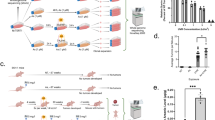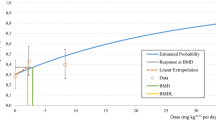Abstract
Quantitative cancer incidence data exist for various laboratory animal models, but little of this information is usable for estimating human risks, primarily because of uncertainties about possible mechanistic differences among species. Acceptance and utilization of animal data for human risk assessment will require a much better understanding of the comparative underlying mechanisms than now exists. A dual-lesion, radiation-track model in rat skin has proven to be consistent with tumor induction data with respect to acute radiation doses ranging from 0.5 up to 10 Gy and higher, and average LETs ranging from 0.34 to 150 keV μm−1 according to the form neoplastic risk (D,L) = CLD + BD2. A recent result with the 56Fe ion beam showed dose-response consistency for malignant (carcinomas) and benign (fibromas) tumor induction with earlier results utilizing argon and neon ion beams. A discrepancy between the model and experiment was found indicating that proportionality of cancer yield with LET did not occur at 150 versus 125 keV μm−1, i.e. tumor yield did not increase in spite of a 20% increase of LET, which suggests that a LET response maximum exists at or within this dose range. Concordance between the model and tumor induction data in rat skin implies that potential intervening complexities of carcinogenic progression fail to obscure the basic radiobiological assumptions underpinning the model. Gene expression microarray analysis shows that vitamin A inhibits the expression of about 80% of the inflammation-related genes induced by the radiation and prevents about 46% of the neoplasms associated with 56Fe ion radiation without appearing to interfere with the underlying dose and LET response patterns. Further validation is needed, but the model has the potential to provide quantitative estimates of cancer risk as a function of dose and LET for almost any type of radiation exposure and even for combinations of different radiations provided only three empirical parameters can be established for each type of radiation and organ system.




Similar content being viewed by others
References
Tlsty T, Briot A, Gualberto A, Hall I, Hess S, Hixon M, Kuppuswamy D, Romanov A, Sage M, White (1995) A genomic instability and cancer. Mutat Res 337:1–7
Iannaccone P, Weinberg W, Deamant F (1987) On the clonal origin of tumors: a review of experimental models. Int J Cancer 39:778–784
Hartwig A, Schlepegrell R (1995) Induction of oxidative DNA damage by ferric iron in mammalian cells. Carcinogenesis 16(12):3009–3013
Chou M, Mikhailova M, Nichols J, Poirier L, Warbritton A, Beland F (2000) Interactive effects of methyl-deficiency and dietary restriction on liver cell proliferation and telomerase activity in Fischer 344 rats pretreated with aflatoxin B(1). Cancer Lett 152:53–61
Rajewsky M, Engelbergs J, Thomale J, Schweer T (2000) DNA repair: counteragent in mutagenesis and carcinogenesis–accomplice in cancer therapy resistance. Mutat Res 462:101–105
Burns FJ, Jin Y, Garte SJ, Hosselet S (1994) Estimation of risk based on multiple events in radiation carcinogenesis of rat skin. Adv Space Res 14:507–519
Rassool F (2003) DNA double strand breaks (DSB) and non-homologous end joining (NHEJ) pathways in human leukemia. Cancer Lett 193:1–9
Vanderlaan M, Burns FJ, Albert RE (1976) A model describing the effects of dose and dose rate on tumour induction by radiation in rat skin. In: Burchenal J, Oettgen H (eds) Biological and environmental effects of low-level radiation. IAEA, Vienna, pp 253–263
Iliakis G, Wang H, Perrault AR, Boecker W, Rosidi B, Windhofer F, Wu W, Guan J, Terzoudi G, Pantelias G (2004) Mechanisms of DNA double strand break repair and chromosome aberration formation. Cytogen Genome Res 104:14–20
Limoli CL, Giedzinski E (2003) Induction of chromosomal instability by chronic oxidative stress. Neoplasia 5(4):339–346
Burns FJ, Albert RE, Garte SJ (1989) Multiple stages in radiation carcinogenesis of rat skin. Environ Health Persp 81:67–72
Burns FJ, Vanderlaan M (1977) Split-dose recovery for radiation-induced tumors in rat skin. Int J Radiat Biol 32:135–144
Yamamoto H, Ochiya T, Takeshita F, Toriyama-Baba H, Hirai K, Sasaki H, Sakamoto H, Yoshida T, Saito I, Terada M (2002) Enhanced skin carcinogenesis in cyclin D1-conditional transgenic mice: cyclin D1 alters keratinocyte response to calcium-induced terminal differentiation. Cancer Res 62:1641–1647
Kellerer A, Rossi H (1978) Generalized formulation of dual radiation action. Radiat Res 75:471–488
Burns FJ, Hosselet S, Jin Y, Dudas G, Garte SJ (1991) Progression and multiple events in radiation carcinogenesis of rat skin. J Radiat Res 32(Suppl 2):202–216
Burns FJ, Chen S, Xu G, Wu F, Tang MS (2002) The action of a dietary retinoid on gene expression and cancer induction in electron-irradiated rat skin. J Radiat Res Suppl 43:229–232
Burns FJ, Zhao P, Xu G, Roy N, Loomis C (2001) Tumor induction in rat skin following single or multiple doses of 1.0 GeV/nucleon 56Fe ions from the Brookhaven Alternating Gradient Synchrotron (AGS). Phys Med Suppl 1:194–195
Coussens L, Werb Z (2002) Inflammation and cancer. Nature 420:860–867
Valko M, Morris H, Cronin MT (2005) Metals, toxicity and oxidative stress. Curr Med Chem 12(10):1161–1208
Tulard A, Hoffschir F, de Boisferon F, Luccioni C, Bravard A (2003) Persistent oxidative stress after ionizing radiation is involved in inherited radiosensitivity. Free Rad Biol Med 35:68–77
Acknowledgments
This work was supported by NASA grant NAG9-1528 and is part of the Nelson Institute of Environmental Medicine and the Kaplan Cancer Center programs supported by grant CA16087 from the National Cancer Institute and Center Grant ES00260 from the National Institute of Environmental Health Sciences.
Author information
Authors and Affiliations
Corresponding author
Rights and permissions
About this article
Cite this article
Burns, F.J., (Eric) Tang, Ms., Frenkel, K. et al. Induction and prevention of carcinogenesis in rat skin exposed to space radiation. Radiat Environ Biophys 46, 195–199 (2007). https://doi.org/10.1007/s00411-007-0106-3
Received:
Accepted:
Published:
Issue Date:
DOI: https://doi.org/10.1007/s00411-007-0106-3




